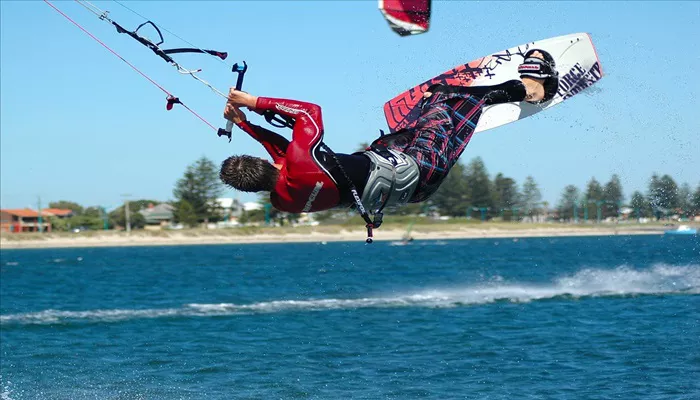Kiteboarding is an exciting extreme water sport. It combines elements of surfing, wakeboarding, and paragliding. A common question among beginners and crossover riders is: Can I use a wakeboard for kiteboarding? This article explores this question in detail. We will compare the equipment, design, and practical use of wakeboards and kiteboards. You will learn if a wakeboard can substitute a kiteboard and what challenges you might face.
Understanding the Differences Between Wakeboards and Kiteboards
Wakeboards and kiteboards look similar but are built for different purposes. Wakeboards are made for being pulled by a boat or cable, while kiteboards are designed to work with the pull of a kite. Knowing their differences helps explain whether they can be interchanged.
Wakeboard Design
Wakeboards are generally shorter and thicker than kiteboards. They have bindings to secure your feet firmly. The shape is designed to create lift and smooth turns behind a boat wake. Wakeboards often have fins underneath to aid stability.
Kiteboard Design
Kiteboards are usually lighter and thinner. They can be twin-tip or directional boards. Twin-tip kiteboards allow riding both directions without turning the board around. Kiteboards have foot straps or bindings but often less rigid than wakeboard bindings. They also have fins but are optimized for riding on flat water and jumping with a kite’s pull.
Can You Use a Wakeboard for Kiteboarding?
The short answer is yes, but with limitations. Using a wakeboard for kiteboarding is possible, especially for beginners or those who want to experiment. However, it is not ideal for all skill levels or conditions. Below are important points to consider.
Advantages of Using a Wakeboard for Kiteboarding
Familiarity: Riders with a strong wakeboarding experience may feel comfortable on a wakeboard when starting kiteboarding.
Stability: Wakeboards tend to be stable because of their shape and bindings.
Cost-effective: Using your wakeboard means no extra cost if you already own one.
Limitations and Challenges
Weight: Wakeboards are heavier, making them harder to control when jumping or riding in strong winds.
Flexibility: Kiteboards are designed to flex for better maneuverability, but wakeboards are stiffer.
Directional Issues: Many wakeboards are directional. This means you have to turn the board to ride back, unlike twin-tip kiteboards.
Binding Rigidity: Wakeboard bindings are tighter and less forgiving, which may limit foot movement during tricks.
Performance: Wakeboards don’t perform well in choppy or flat water typical of kiteboarding conditions.
Wakeboarding Gear Versus Kiteboarding Gear
Choosing the right equipment improves safety and performance. Wakeboarding gear and kiteboarding gear differ in several ways. Understanding these helps decide if you should use a wakeboard for kiteboarding or invest in kiteboarding-specific gear.
Wakeboarding Gear
Wakeboarding gear includes a wakeboard, boots or bindings, helmet, and life vest. The bindings are made to hold the rider’s feet tight for pulling behind a boat. The gear is designed for high impact and tight control.
Kiteboarding Gear
Kiteboarding gear consists of a kite, control bar, kite lines, harness, kiteboard, and safety equipment. The kiteboard is lighter with flexible bindings or foot straps. The harness supports the rider’s body weight and connects to the kite. Safety systems allow quick release in emergencies.
For the best kiteboarding experience, using wakeboarding gear alone is insufficient. Kiteboarding gear is designed for the unique forces and movements involved.
Practical Tips for Using a Wakeboard in Kiteboarding
If you decide to use a wakeboard for kiteboarding, keep these tips in mind to improve your experience and safety:
Choose the Right Wakeboard
Pick a wakeboard that is medium in length and not too heavy. Boards with a flatter bottom will perform better on the water surface.
Use Adjustable Bindings
Adjust your bindings to allow some flexibility in foot movement. This helps with balance and trick execution.
Practice in Calm Conditions
Start in calm water and light wind. This reduces the challenge and helps you get used to the differences.
Understand the Kite’s Pull
The kite pulls differently than a boat. Expect a varied speed and direction. Focus on controlling the kite and maintaining balance on the wakeboard.
When Should You Invest in a Kiteboard?
While a wakeboard can work for some beginners, serious kiteboarding requires a proper kiteboard. Reasons to switch include:
Improved Performance: Kiteboards provide better control, speed, and easier jumps.
Greater Comfort: Lighter boards and flexible bindings reduce fatigue.
Enhanced Safety: Designed safety features for kiteboarding reduce injury risk.
Better Durability: Kiteboards are made to handle the stress from kite forces and water conditions.
Conclusion
Yes, you can use a wakeboard for kiteboarding, but it is not the best choice for long-term or advanced kiteboarding. Wakeboards offer stability and familiarity but lack the flexibility and design features that kiteboards provide. For beginners or riders transitioning from wakeboarding, using a wakeboard can be a helpful start. However, investing in kiteboarding-specific gear will significantly improve performance and enjoyment.

